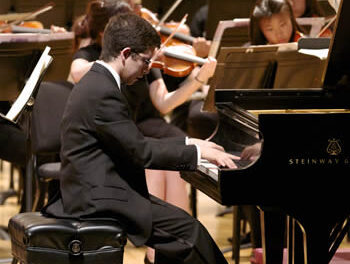The Hendersonville Symphony Orchestra celebrated its Fortieth Anniversary with a gala concert, a program whose selections represented the history of the ensemble. A normal concert is judged according to musical values, focusing on the performance quality and the coherence of the programming. For a gala concert, there is a whole other plane on which one judges: did the gala achieve its purpose as a celebration of some milestone? Without any reservation, I can state that the gala was a successful celebration of those forty years.
The orchestra has had five music directors in its history, and three of them were in attendance: Jim Stokes (director 1971-1975) in the audience, Manuel Alvarez (director 1994-1998) who guest conducted one piece, and Thomas Joiner (director since 1998) who conducted the remainder of the program. Five musicians who had performed at the opening concert (December 6, 1971) were in the audience, and were introduced by Ron Whittemore during a several-part narrative that recounted the history.
Whittemore concentrated especially on the HSO’s central importance to the entire music scene in Henderson County and the surrounding area. The orchestra initiated a string program in the public schools (since taken over by the school system) and is still very involved in education with the Hendersonville Symphony Youth Orchestra for teenagers and the Sinfonietta for very young string players, with a summer string camp, educational concerts for third and sixth graders, scholarships and an annual competition for instrumentalists. The Orchestra has collaborated with the Greenville Chorale, the Asheville Symphony Chorus, the North Carolina Stage Company, and frequently with Flat Rock Playhouse. The evening’s program was planned to exemplify these connections.
There were three substantial works performed in the first half of the concert. Maestro Alvarez conducted the first movement of Franz Joseph Haydn’s Symphony No. 104 (the “London” Symphony), a work that was on the program of the inaugural concert. Alvarez conducts with a very clear beat, commanding eye contact with the players, and good use of the left hand. Some might consider that he overconducted, with details that one would use for a training orchestra, but given that he is not used to these players it is far better to overconduct than to assume too much. Maestro Joiner conducted the first movement of Beethoven’s Symphony No. 5, in recognition of the complete Beethoven symphony cycle that the orchestra has presented during the last five years. I found that the Beethoven got off to an understated start, but settled down mid-movement.
The high point of the first half was the Saint-Saëns Concerto No. 1 for Cello and Orchestra (Opus 33) with Franklin Keel as soloist. Keel, who won the Young Artist Competition in 2002 and returned to the area after receiving his degrees from Eastman School of Music, played the same work when he competed. This concerto is most appropriate to his playing. His double stopping sent shivers up my spine. He has a small but delicious tone, reminding me of Alan Harris and perhaps more suited for chamber music (Keel is a founding member of the Opal String Quartet) but he shines in the romantic repertoire where beauty is more important than muscle.
In the second half of the program, the fare was “pops” with works arranged by Bruce Chase and Calvin Custer and with Broadway vocals by Justin Patterson, who spent time at Flat Rock Playhouse over six seasons and is now a New York City resident. The second half of the program also included shenanigans by Scott Treadway, who took photographs while wandering through the hall and the stage. This was nostalgia indeed, since Treadway has appeared several times with the HSO in pops programs during his years at the Flat Rock Playhouse.
Does this happy attendee have any criticism to make? Only that the program had a little too much talk and was a little too long. Some audience members were leaving during the final two numbers, after a 2-1/2 hour marathon. But then, it’s in the nature of a gala to go on and on, isn’t it?












